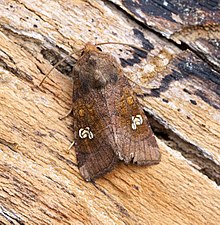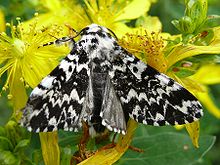| Owlet moths | |
|---|---|

| |
| Amphipoea oculea | |

| |
| Panthea coenobita | |
| Scientific classification | |
| Domain: | Eukaryota |
| Kingdom: | Animalia |
| Phylum: | Arthropoda |
| Class: | Insecta |
| Order: | Lepidoptera |
| Superfamily: | Noctuoidea |
| Family: | Noctuidae Latreille, 1809 |
| Type species | |
| Noctua pronuba | |
| Subfamilies | |
| |
| Diversity | |
| About 11,772 species | |
The Noctuidae, commonly known as owlet moths, cutworms or armyworms, are a family of moths. Taxonomically, they are considered the most controversial family in the superfamily Noctuoidea because many of the clades are constantly changing, along with the other families of the Noctuoidea.[1][2][3] It was considered the largest family in Lepidoptera for a long time, but after regrouping Lymantriinae, Catocalinae and Calpinae within the family Erebidae, the latter holds this title now.[4] Currently, Noctuidae is the second largest family in Noctuoidea, with about 1,089 genera and 11,772 species.[5] This classification is still contingent, as more changes continue to appear between Noctuidae and Erebidae.
- ^ Regier, Jerome C.; Mitter, Charles; Mitter, Kim; Cummings, Michael P.; Bazinet, Adam L.; Hallwachs, Winifred; Janzen, Daniel H.; Zwick, Andreas (1 January 2017). "Further progress on the phylogeny of Noctuoidea (Insecta: Lepidoptera) using an expanded gene sample". Systematic Entomology. 42 (1): 82–93. Bibcode:2017SysEn..42...82R. doi:10.1111/syen.12199. ISSN 1365-3113.
- ^ Lafontaine, J. Donald; Fibiger, Michael (1 October 2006). "Revised higher classification of the Noctuoidea (Lepidoptera)". The Canadian Entomologist. 138 (5): 610–635. doi:10.4039/n06-012. ISSN 1918-3240. S2CID 86122393.
- ^ Michael, Fibiger; Donald, Lafontaine, J.; H., Hacker, Hermann (1 January 2005). A Review of the Higher Classification of the Noctuoidea (Lepidoptera) With Special Reference to the Holarctic Fauna. Beilage zu Band 11: (Notodontidae, Nolidae, Arctiidae, Lymantriidae, Erebidae, Micronoctuidae, and Noctuidae): Gesamtinhaltsverzeichnis Bände 1-10: Indices Bände 1-10. Delta-Druck und Verlag Peks. ISBN 978-3938249017. OCLC 928877801.
{{cite book}}: CS1 maint: multiple names: authors list (link) - ^ Zahiri, Reza; Holloway, Jeremy D.; Kitching, Ian J.; Lafontaine, J. Donald; Mutanen, Marko; Wahlberg, Niklas (1 January 2012). "Molecular phylogenetics of Erebidae (Lepidoptera, Noctuoidea)". Systematic Entomology. 37 (1): 102–124. Bibcode:2012SysEn..37..102Z. doi:10.1111/j.1365-3113.2011.00607.x. ISSN 1365-3113. S2CID 84249695.
- ^ Zhang, Z.-Q., ed. (23 December 2011). "Animal biodiversity: An outline of higher-level classification and survey of taxonomic richness". Zootaxa. 3148. Magnolia Press: 217. ISBN 9781869778491.